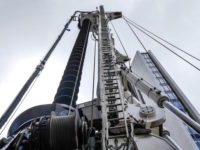During a large seismic event along the Wellington fault, Prince says, “it is possible for susceptible layers in the soil to liquefy” and affect the performance of the bridge. The design team took pains to confirm that the performance of the bridge would be acceptable in such an event.
Prince continues, “The bridge stub is generally sound. Its foundations were upgraded as part of the Thorndon Overbridge seismic retrofit in the late 1990s. But it’s a technically challenging task to lift and move a 300-tonne, two-piece bridge. To achieve the task, the team will use up to eight hydraulic jacks, each capable of lifting 100 tonnes. The jacks are linked and controlled by a computer that synchronizes them to within a 1-mm tolerance. This ensures each part of the bridge is lifted evenly and equally, as any significant difference could cause the structure to crack, reducing its integrity.”
First, the stub bridge will be lifted some 150 mm off its foundations; the jacks will continue to hold the bridge in its lifted position for a day, while a temporary steel holding structure is assembled in place. Next, the bridge will be lowered onto its temporary holding structure. During this time, the existing foundations will be demolished and new ones built to the correct position and height.
Once it is lowered a full meter onto, and connected to, its new permanent foundations, the bridge will be pushed 1.5 meters sideways to its new position, approximately 800 mm from the existing roadway on the Thorndon Overbridge. Steel reinforcing rods then will be drilled and inserted horizontally into both the stub bridge and the overbridge. Next, these dowel rods will be connected, and concrete will be poured into the space, closing the gap and effectively "stitching" together the bridges. It will take engineers at least two months to prepare, move and then settle each 30-m span of the stub bridge into position. The first span will be moved this month, and the second will be placed in April.
Wellington’s first smart motorway, in which traffic flows are actively monitored and managed by traffic operators through a network of sensors and radars, cameras, and speed and lane control signs, is due to be operational by April 2016.


